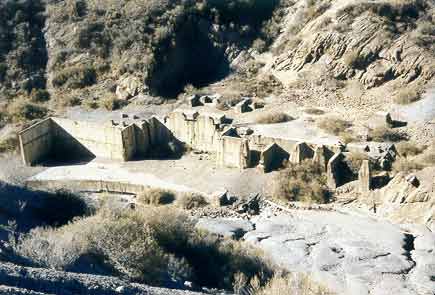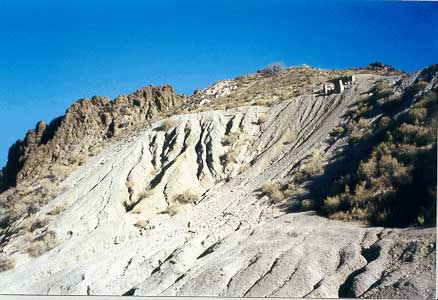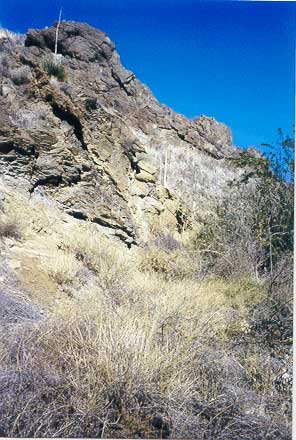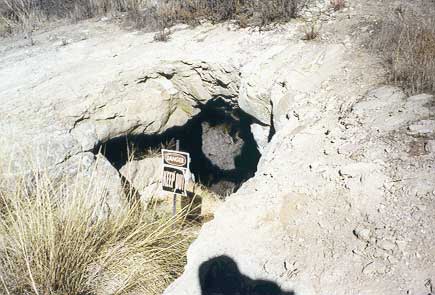
View to the north from Davenport Road, with Sterling Borax Mine dump in the background
by Al Wilkins & Bob Housley
January 2000
Introduction
Tick Canyon has been a well known collecting area for Southern Californians for many years, being most famous for its high quality howlite nodules. Among specialists it is also known as the type locality, and perhaps the only accessible locality, for the very rare strontium borate veatchite. Micro mineral collectors also know it as a source for nice sharp natrolite and analcime crystals, and in earlier times it was known for agates on the nearby hills. We recently were on a trip to the site led by the Sierra Polona Mineral Club and thought it would be fun to review some of the history of the site and describe the collecting opportunities as we currently found them. A map and additional photos are posted on the web at http://showcase.clubphoto.com/cgi-bin/scdetail.las?recid=6577. These can also be found by going to http://clubphoto.com/ and then typing in the e-mail address for RMH.
Note from the webmaster: Also look at http://home.earthlink.net/~rhyde83/photoalbum/contents.htm
Location
Tick Canyon lies in the Soledad Basin, and represents a tributary of the Santa Clara River channel. Tick Canyon lies between Mint Canyon to the west and Tapie and Spring Canyons to the east. It is nearly equidistant from Sierra Highway to the west and the Antelope Valley Freeway (State Highway 14) to the east, and can be reached via Davenport Road (off Sierra Highway or by way of the Aqua Dulce Canyon Road turnoff from Hwy. 14). Elevation of most of the collection sites described below is in the range of 2,150 to 2,350 feet by GPS.
The Sterling Borax mine (also known as the Lang Mine) at Tick Canyon is located at N ½ NE 1/4 Sec. 32, T5N, R.14W, S.B.M., about 3 ½ miles north of the former Southern Pacific Railroad siding of Lang, though this is rarely found on maps today.
Geology
The borate minerals at Tick Canyon occur in shale beds in the continental (i.e., non-marine) Oligocene Vasquez formation. The Vasquez series is composed principally of red, green and yellowish sandstone, arkose (partly tufaceous), mudstone, and conglomerate, interbedded with andesite and basalt. The Vasquez series in the vicinity of the Sterling borax mine was deformed into north-east trending folds, modified by many cross-fault and longitudinal faults. The interlaying of competent volcanic rocks with incompetent sedimentary sequences contributed to the structural complexity of the area. The predominantly sedimentary nonmarine Miocene Tick Canyon and Mint Canyon Formations overlap the distorted Vasquez beds north and south of the mine area.
The beds carrying commercial colemanite were among the finer grained in the formation and consisted of thinly bedded red and brown sandstone, mudstone, and a purply silty shale, near the top of the Vasquez formation and between vesicular flows of basalt. The principal beds were up to 30 feet thick and about 1,000 feet long, striking north 75o west and dipping about 70o south on the north flank of a syncline plunging gently south-west. Thinner, subcommercial colemanite layers and several thin howlite-bearing strata were also described.
Less than 1/4 mile east of the Sterling borax mine, the beds were offset approximately 1,000 feet to the northeast by left-lateral movement on the Tick Canyon fault. East of the fault, the borate beds could be traced for about 2 miles; the strike of the beds changed to due west, but the steep dip was maintained.
Geologists disagree on the origin of the borate deposit at Tick Canyon. Eakle (1911) stated that the original site was probably “a marshy area with mud, marl, calcareous tufa, and abundant organic matter, and that waters charged with boric acid converted calcium carbonate into calcium borate.” Foshag (1921), Murdoch and Webb (1954), and other experts suggest that the area was most likely a borax-ulexite playa, similar to the present floor of Death Valley, and that, after uplift and tilting, sodium was removed in solution and boron combined with calcium from calcareous sediments and limestone to form colemanite. Most geologists do agree that the boron originated in the associated volcanic rocks.
The strong monomineralic character of the deposit and the lack of mixed alkali salts indicate that the deposit was not formed directly by the evaporation of desert lake waters.
Mining History
1906, gold prospectors Henry Shepherd and Louis Ebbenger were driving a tunnel deep into an old Spanish mine in the Santa Clarita Valley when they noticed a white formation in the cliffs below. A few strikes with a rock pick revealed colemanite crystals, indicating a high-grade borate deposit. They staked a claim to the area. Having no experience in borate mining, Shepherd and Ebbenger sold the Tick Canyon prospect to Thomas Thorkildsen, whose borax mine on Frazier Mountain in Ventura County was already showing signs of playing out, for $80,000. Thorkildsen formed the Sterling Borax Company, which represented a consolidation of borax interests, including: Stauffer Chemical Company’s Frazier Borate Mining Co. (holder of the mine in Ventura Co.), American Borax Co. (holder of the boric acid works at Daggett), the Brighton Chemical Co. (refinery in Pennsylvania), and Thomas Thorkildsen & Co. (refinery in Chicago).
The mine was active from 1908-1918, and it represented the county’s only borate deposit. Colemanite was mined through two vertical shafts, each 350 feet deep, from workings on the 100-200-300 foot levels and from numerous auxiliary openings. The deposit was mined along a vein for a distance of 800 to 1,000 feet, one segment of about 600 feet being mined on all three levels. Mining methods included the use of shrinkage stopes and square-set stopes. The shrinkage stopes were about 70 feet long, 60 feet high, and 20 feet wide above the ore chutes. The square-set stopes were 40 to 60 feet wide, 70 feet long, and 60 feet high. Pumping was required to keep the lower levels free of water.
During the earliest operations, colemanite was sacked for shipment, but four oil-burning calcining furnaces were later installed. Two of these were wedge furnaces, with a capacity of about 40 tons each per 24 hours; the other two were horizontal furnaces 50 feet long with a capacity of 60 tons each. After the water of crystallization was driven out by roasting, the bulk of the admixed shale impurity was removed by passing an air current through a cone screen. In this way a refined ore, 48 to 50% boric acid (B2O3), was produced.
Thorkildsen replaced the fabled mule teams with a private 6-mile standard-gauge railroad spur running from the mine to Lang Siding of the Southern Pacific Railroad (It was at Lang station that Southern Pacific joined up its San Francisco and Los Angeles lines in 1876). A “dinkey”-type engine puffed up and then backed down the hill, hauling 20,000 tons of marketable ore to the depot, which also served as a shipping point for the area’s cattle and grain. The bulk of the refined ore was shipped to the several eastern refineries of the Sterling Borax Co. for conversion to commercial borax.
The town of Lang grew to a population of nearly 1,000 people. About 300 men were employed at the Sterling Borax mine, including 80 at any one time. The maximum daily production was about 400 tons, and an output of nearly $500,000 worth of calcium borate was credited to the mine for the year 1914. During World War I, mine production was limited by a shortage of railroad cars available to ship the ore. Unpublished records of the California Division of Mines indicate that the total production during the 16-year life of the mine was about 100,000 tons of ore, valued at about $3 million. The mine yielded a substantial share of the colemanite mined in the United States from 1908 to 1920. During the latter portion of the period from 1911-1918, during which the deposit was nearly mined out, the Pacific Coast Borax Co. entered into a sales agreement with the Sterling Borax Co., but did not own or operate the site. In 1921 the Sterling Borax Co., faced with declining prices for borax and rising mining costs as the mine deepened, sold the nearly depleted deposit to the Pacific Coast Borax Co., which conducted a “scavenging operation” to extract the remainder of known colemanite from the site. The mine closed in 1922, and the plant was dismantled in 1926. The development of a rich deposit of the sodium borate kernite at Boron in 1926 marked the end of extensive mining of colemanite in California. In 1954 the Sterling mine workings were reported to be “caved to an unknown extent and full of water below 150 feet”.
Current Conditions
Although the land is for sale the site is still owned by the U.S. Borax Co., which recently made an agreement with the Sierra Pelona Rock Club of Newhall to host 3 field trips per year onto the property. The workings have now been back filled and the surface recontoured, but much of the old dump is still accessible. The dumps in the lower part of the canyon below the old mill site and south of Davenport Road are darker in color than the upper dumps and appear to have been through the calcining furnaces. Therefore little of interest is expected in them. The dumps further upstream and higher in elevation are highly variable from place to place and still contain lot of interesting material.
Mineralogy
Colemanite (Ca2B6O11.5H2O) was discovered at Tick Canyon in 1909. It was initially termed “neocolemanite” by Eakle in 1912, but subsequently shown by Hutchinson in the same year to be identical to colemanite. It occurred here in a massive form, often with divergent columnar structure. Much of the material was gray due to included mud. Crystals were quite rare and occurred in three distinct habits, described by Eakle (1911). Originally the most plentiful mineral here, it is now commonly found on the dump as satiny gray chunks of the massive material resembling satin spar and rarely as cleavage fragments having a glassy luster.
More plentiful colemanite cleavage fragments can be found on the dump of a smaller prospect to the east, marked by a mine tunnel, the bottom of which is full of water and forms the source of a small year round stream. See photo 6. Besides small pieces of micro howlite on shale, we found some small lumps of botryoidal material that appear to be bakerite and some very small sparkly crystals in shale that proved in the scanning electron microscope to be chabazite on this dump. GPS coordinates for this prospect are: 34o 28.96' N and 118o 21.55' W.
Cauliflowerlike nodules of the hydrous borosilicate howlite [Ca2B5SiO9(OH)5.5H2O] are still abundant in the Sterling borate deposit. The nodules range from marble-sized to boulders a foot or more in diameter and weighing several hundred pounds. Color ranges from almost pure white through gray to almost black. While not hard (3.5 on Moh’s scale), howlite from this location nevertheless takes a fine polish, and white specimens with porcelain-like interiors and widespread carbonaceous “spider-webbing” (originating from the black shale in which the colemanite was interbedded) are prized by lapidary enthusiasts. Some specimens are said to show sky-blue fluorescence under long-wave ultraviolet light, weaker under short-wave, though our examination of hundreds of individual pieces of howlite from the locality and an informal survey of local fluorescent mineral enthusiasts could not confirm this. White rosettes of minute tabular howlite crystals are also found there on the surface of a small fraction of the massive howlite nodules, permitting the determination of X-ray and crystallographic data for this mineral by Murdoch in 1957. These crystals range to slightly greater than 2 mm in their largest dimension. They are sometimes free-standing, but more often the core of anhedral translucent howlite, so that the whole looks like a small sandwich. These crystals are thought to have formed as part of the primary deposit of howlite. We found two of these nodules showing howlite micro crystals.
Pemberton (1968) reported finding white rosettes of diamond-shaped crystals, similar in habit but smaller than the crystals described by Murdoch, in vugs and crevices of porous gray marl at the Tick Canyon site in 1967. He said these crystals appeared clear, without mud inclusions or the covering of clay that coats much of the primary howlite and other materials on the dumps there. We did not find any of these.
Howlite was first described by Henry How in 1868 as nodules in anhydrite associated with ulexite near Windsor, Hants Co., Nova Scotia. About 40 years later, it was discovered in California in the Calico Mts. near Daggett; with colemanite near Ryan, in Death Valley; and from the head of Tick Canyon.
Microcrystalline crusts of the hydrous calcium borosilicate bakerite [Ca4B4(BO4)(SiO4)3(OH)3. H2O, frequently with a botryoidal form, were reported on cavities in shale at the Sterling Borax mine by Murdoch (1956). Later, Murdoch (1962) reported finding measurable crystals up to 0.2 mm in maximum diameter on the surface of the bakerite crusts. The crystals are reported to occur in two distinct habits, one a stout, obliquely terminated rhombic prism up to 0.2 x 0.1 mm, and the other a tabular, diamond-shaped crystal up to 0.2 x 0.2 x 0.05 mm. We did not find any bakerite crystals, and only a small amount of the botryoidal variety at the prospect described above.
Celestine (SrSO4) was found as clusters of crystals partially filling vugs in the marl, as crystals on the microcrystalline bakerite coatings of fissures and vugs in the limestone, and as minute crystals perched on the “mountain leather” variety of the calcium-magnesium silicate tremolite [Ca2Mg2Si8O22(OH)2] at this locality. Most of the celestine crystals are small, but one specimen reported by Pemberton (1968) contained prismatic crystals up to 20 x 3 mm. We only found micro crystals of celestine in one sample.
Tick Canyon is also the type locality for the hydrous strontium borate veatchite [Sr2B11O16(OH)5.H2O] which was first described in 1938. Veatchite occurs here as pearly cross-fiber seams up to 6 mm across in shale, howlite, colemanite, limestone or marl, and as nests of radiating pearly plates in the same matrix materials. Whether the latter platy form is veatchite or its dimorph p-veatchite, with different crystallography, has been the subject of controversy for many years. We were still able after all this time to find quite a bit of this rare material in parts of the dump.
The sodium and calcium borate probertite [NaCaB5O7(OH)4.3H2O] occurs on the Sterling Borax mine dump as flattened, lenticular aggregates or rosettes of “slender radiating prisms” or coarse needles up to 15 mm x 0.5 mm. Most of the specimens collected today have altered on the surface to ulexite, and in so doing have become softer. In one area of the dump this is very plentiful.
Ulexite [NaCaB5O9.8H2O] is found here as fragile, small, rounded cotton-balls of radiating needle-like prismatic crystals, and as compact, divergent, satiny white fibrous aggregates. Foshag (1918) quotes a hardness of 3.5, higher than that usually associate with the species. It is more frequently found here today as a surface alteration of probertite.
During the drier seasons of the year, an efflorescence of borax [Na2B4O5(OH)4.8H2O] appears along the edge of the rivulet (see photo 2) below the main dumps of the Tick Canyon borate deposit, soon converting to tincalconite [Na2B4O5(OH)4.3H2O].
The zeolite analcime [NaAlSi2O6.H2O] has been found, rarely, as scattered crystals perched on bakerite and with pyrite in the asphaltum shale at the Sterling Borax mine in Tick Canyon. In a thin basalt flow about 0.2 mile north of the Sterling Borax mine, abundant clear to snowy white analcime and occasional delicate sprays of clear natrolite [Na2Al2Si3O10.2H2O] occur in vesicles. This site can be reached via a dirt trail, about 4 minutes north of a massive red basalt outcropping at the northern extent of the mine dump. You will arrive at the site soon after scrambling over a natural red basalt cascade in the path. You will likely see an exposure of hematite-rich vesicular basalt in the foot path. Follow the exposure up the short hill to the west. GPS coordinates for the most productive part of the exposure are: 34o 28.77' N and 118o 21.92' W. To obtain the cleanest, least fractured, least-weathered, and least iron-stained natrolite specimens, it is necessary to break up the basalt in this area; your efforts will be rewarded.
Thin, transparent, tabular crystals of heulandite up to 2 mm were reported in Minerals of California by Pemberton from tiny vesicles in an exposure of the metavolcanics, a few yards north of the Sterling Borax mine dumps. Since heulandite and clinoptilolite can be distinguished only by a careful determination of the Al/Si ratio and clinoptilolite was believed to be a rare mineral at the time Pemberton wrote his account, we believe that he just assumed this was heulandite. Our analysis indicates that it is clinoptilolite.
We noted mordenite in an outcropping of amygdaloidal basalt a few minutes north of the previously described analcime/natrolite site, associated with occasional hollow balls made up of tiny octahedra of cristobalite (SiO2). Many of the amygdules at the site are lined with brownish clinoptilolite. Chalcedony, in shades of white, gray, pale blue, and chlorite-stained bluish green, is common in vugs of the basalt at this site, and occasional collections of clear quartz xls in vugs may also be seen. To reach the mordenite site, proceed north from the analcime/natrolite site over a sandstone exposure stretching off to your left. Climb over a basalt rock waterfall and then walk a short distance along a small stream. Just beyond a huge roll of blue plastic in the wash/stream lies the mordenite site. See photos 5. GPS coordinates for the site are: 34o 29.09' N and 118o 21.80' W.
Orange crystals of clinoptilolite can also be found on a face of weathering chlorite-stained andesite a few yards east of the foot path, just inside (i.e., north of) the metal fence off Davenport Road. GPS coordinates for this site are: 34o 28.77' N and 118o 21.92' W.
Pemberton (1968) also reports small crystals of the iron sulfide pyrite (FeS2) in the black asphaltum shale on the dumps at Tick Canyon. Extremely rare occurrences of the sulfides realgar (AsS), arsenopyrite (FeAsS), and stibnite (Sb2S3) have also been reported there.
In the past, the basalt outcrops surrounding the dumps have yielded abundant agate-, opal- and quartz-lined nodules, attractive blue and white fortification agate, seam agate, and some bloodstone, but this material is now scarce.
References:
Armstrong, V.L and Van Amringe, E.V. (1948) Tick Canyon Field Trip. Reprinted from Grieger’s Encyclopedia and Su per-Catalog of the Lapidary and Jewelry Arts. Pasadena.
Carnahan, V. (1967) Minerals of Los Angeles County, Part 1. Catalina Island, Palos Verdes, and Soledad Basin. Los Ange les County Natural History Museum Alliance Quarterly, 6, No. 4, 20-24.
Clark, J.R. and Mrose, M.E. (1960) Veatchite and p-veatchite. Am. Mineral. 45, 1221-1229.
Eakle, A.S. (1911) Neocolemanite, a variety of colemanite, and howlite from Lang, California. Univ. Calif. Dept. Geol. Sci. Bull. 6, 179-189.
Foshag, W.F. (1918) Ulexite from Lang, California. Am.
Mineral., 3, 35 & Mineralog. Abstracts, 1, 341.
(1921) The origin of the colemanite deposits of California. Econ. Geol., 16, 199-214.
Gale, H.S. (1914) The origin of colemanite deposits. U.S. Geol. Surv. Prof. Paper 85, 3-9.
Gay T.E., Jr. and Hoffman, S.R. (1958) Mines and mineral
deposits of Los Angeles County, California. Calif. Jour. Mines and Geol., 50, 506-508.
Hutchinson, A. (1912) On the identity of neocolemanite with colemanite. Mineralog. Mag., 16, 239-246.
Kramer, H.C. and Allen, R.D. (1956) A restudy of bakerite, priceite, and veatchite. Am. Mineral. 41, 689-700.
Luce, J.W. (1935) A field trip to Tick and Red Rock Canyons. Pacific Mineral., 2, 14-17.
Mitchell, J.R. (1984) Howlite and other minerals in Tick Can yon. Gems and Minerals, 558, 16-19.
Murdoch, J. (1945) Probertite from Los Angeles County, Cali fornia. Am. Mineral., 30, 719-721.
(1957) Crystallography and X-ray measurement of howlite from California. Am. Mineral. 42, 521-524.
(1962) Bakerite crystals. Am. Mineral., 47, 919-923.
Murdoch, J. and Webb, R.W. (1954) Minerals in Southern California. Calif. Div. Mines and Geol. Bull. 170, ch. VII, 5- 12.
(1956) Minerals of California. Calif. Div. Mines Bull. 173, 452 pp.
(1964) Minerals of California for 1958 through 1961: Sup plement 2 to Bull. 173, Calif. Div. Mines and Geol.
Masimer, G.E. (1966) Tick Canyon revisited. Gems and Min erals, 347, 20-23.
Oakeshott, G.B. (1958) Geology and mineral deposits of San Fernando quadrangle, Los Angeles County, California. Calif. Div. Mines Bull. 172, 147 pp.
Pemberton, H.E. (1968) The minerals of the Sterling Borax Mine, Los Angeles County, California. Mineral Explorer 3, 1-10.
(1968) A new zeolite locality—overlooked 115 years ago. Mineral Explorer 2, 1-8.
(1971) Type locality for bakerite. Am. Mineral., 56, 1109- 1110.
Sharp, W.E. (1959) Minerals from Los Angeles County,
California. Printed privately, Los Angeles, California.
Switzer, G.S. (1938) Veatchite, a new calcium borate from Lang, California. Am. Mineral., 23, 409-411.

View
to the north from Davenport Road, with Sterling Borax
Mine dump in the background

View
of the Sterling Borax Mine dump from the foot path, beside a small rivulet,
looking ENE

Ruins
of the Sterling Borax plant looking south from the foot path

Sterling
Borax Mine dump, looking ENE from the foot path

Amygdaloidal
basalt exposure where mordenite may be collected

Small
colemanite prospect and dump. A close-up of the mine opening is shown